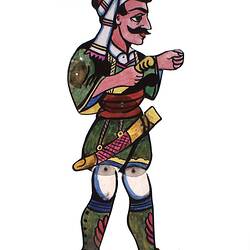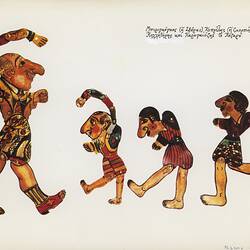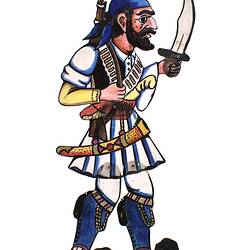Summary
This set of curtains was commissioned in early 1960 by the Greek puppeteer and popular artist Abraam (Antonakos). It was made by an unknown dressmaker at her workshop in the same neighbourhood where Abraam lived. Abraam used the curtains during performances in Greece during the 1960s. These curtains and most of the puppets and accessories in the collection were brought to Australia by Abraam Antonakas for his performances at the Astor Theatre in Melbourne in 1977. He then left the collection with Dimitri Katsoulis who used them in all his subsequent performances in Victoria and in South Australia from 1978 to 1991. Dimitri Katsoulis migrated to Australia in 1974 to escape a regime that repressed Greek artists. He had trained in Greece with theatre and film companies as an actor and technician. A master of the traditional Greek shadow puppet theatre, his performances explored contemporary issues such as the isolation of migrant women and children. Unable to obtain funding and support, he returned to Greece in 1991, leaving his entire collection to the people of Victoria. It includes 32 shadow puppets and around 170 props, set backdrops and technical tools and stage equipment. Dimitri has since returned to Melbourne and assists the Museum to continue to document this rich art form within both local and international contexts.
These curtains were used in all the traditional Greek Shadow Puppet Theatre performances as part of the intergral infrastructure of the stage construction. The curtains have several parts:
A curtain that is placed on the right side of the stage by means of a wooden support frame. Its purpose is to conceal the puppeteers from the view of the audience during a performance.
A curtain that is fixed to the bottom horizontal beam of the stage and it hung to the floor. Its purpose is to conceal the bottom part of the backstage area from the audience.
A curtain that is placed from the top left hand horizontal beam to the bottom of the screen of the stage. Its purpose is decorative and to cover the joint of the screen to the horizontal beam of the stage.
A curtain that is placed from the top right hand horizontal beam to the bottom of the screen of the stage. Its purpose is decorative and to cover the joint of the screen to the horizontal beam all the way to the bottom of the stage.
A curtain that is placed on the top horizontal beam from one side of the stage to the other side of the stage. Its purpose is decorative and to cover the joint of the screen to the horizontal beam of the stage.
Information supplied by Greek Shadow Puppet Theatre master Dimitri Katsoulis, 2007.
Physical Description
A curtain of red brocade, with selvedges on two sides and machine-stitched hemming at both ends. The pattern consists of stripes running lengthwise along the fabric. Within the stripes are two alternating patterns, one of leaves and flowers, the other a geometric pattern of circles and diamonds.
Significance
This collection of puppets, props, stage sets, and technical tools and equipment relating to traditional Greek Shadow Puppet Theatre is unique in Australia and rare in international public collections. The history of Greek Shadow Puppet Theatre, its puppet characters and the methodology of its performance has been recorded in partnership with the puppet master to whom the collection belonged. The collection is highly significant both as documentation of an important cross-cultural, centuries-old art form, and as an example of the transnational migration of cultural activity between Greece and Australia. It is a collection which was created and performed in Greece and Australia from the mid to late twentieth century, by two puppet masters, who transported the tradition between two countries. Abraam Antonakos came to Australia in 1977 to perform the puppet theatre and then deposited the puppets with Dimitri Katsoulis, who had migrated to Australia in 1974. Dimitri's story becomes one of migration experience, cultural maintenance and adaptation, and finally return migration and the discontinuance of this cultural art form in Australia.
More Information
-
Collection Names
-
Collecting Areas
-
Acquisition Information
Purchase
-
Commissioned By
-
User
-
User
-
User
-
Classification
-
Category
-
Discipline
-
Type of item
-
Overall Dimensions
147 cm (Length), 480 cm (Height)
-
References
[Link 1] Malkin, Michael, R. Traditional and Folk Puppets of the World, A.S. Barnes & Co., Inc., N.J., 1977; Simmen, Rene, The World of Puppets, Elsevier, Phaidon, London, 1975; Hogarth, Ann & Bussell, Jan, Fanfare for Puppets!, David & Charles Publishers Ltd, USA, 1985; Yayannos, A & Ar and Dingli, J. The World of Karaghiozis, 1976
-
Keywords
Cultural Maintenance, Greek Communities, Greek Immigration, Karaghiozis Theatre, Shadow Puppetry, Theatres, Working Life


